Curious about how barcode indexing for digital transformation can revolutionize your digital efforts? Uncover the top 6 insights that shed light on the transformative power of barcode indexing in optimizing processes, enhancing productivity, and fostering streamlined operations. From unlocking efficiency gains to navigating challenges in transitioning, these insights offer a comprehensive view of how barcode indexing can pave the way for a data-driven future. Explore the key strategies and trends that are reshaping the digital landscape and discover how barcode indexing plays a pivotal role in driving organizational success.
How Barcode Indexing Drives Transformation
Barcode indexing plays a crucial role in driving digital transformation within organizations. By implementing barcode indexing systems, businesses can significantly increase efficiency and optimize organization. Barcode indexing involves assigning unique codes to documents, assets, or products, which can then be scanned for quick identification and retrieval. This method streamlines processes such as inventory management, document tracking, and data entry.
Through barcode indexing, organizations can automate data entry tasks, reducing the risk of human error and saving time. This automation leads to increased efficiency in various operational areas, allowing employees to focus on more strategic tasks. Furthermore, the ability to quickly locate and retrieve information using barcodes enhances productivity and decision-making processes.
Enhancing Digital Archives With Barcode Indexing
Enhancing digital archives with barcode indexing can significantly improve search capabilities by enabling quick and precise retrieval of specific documents. By implementing barcode indexing, you streamline the process of locating and accessing archived information, saving valuable time and resources. This enhancement ultimately leads to increased efficiency and productivity within your digital archive management system.
Improved Search Capabilities
Digitizing and organizing vast amounts of information in digital archives can present challenges in efficiently retrieving specific data. Barcode indexing offers improved search capabilities by enhancing search efficiency and user experience. By assigning unique barcodes to each document or asset, data organization becomes streamlined, enabling quick identification and retrieval. This system also enhances asset tracking, allowing for real-time monitoring of the location and status of each item within the archive.
With barcode indexing, users can simply scan the barcode to access detailed information about the corresponding item. This eliminates the need for manual searches through extensive digital archives, saving time and improving overall productivity. The increased search efficiency provided by barcode indexing not only benefits the users but also enhances the overall functionality of the digital archive system. By leveraging barcode technology for indexing, organizations can optimize their search capabilities, providing a seamless experience for users navigating through the vast digital repository.
Streamlined Retrieval Process
Amid the ongoing digital transformation, the need for efficient retrieval processes within digital archives has become increasingly paramount. Barcode indexing plays a crucial role in streamlining retrieval processes, leading to increased efficiency and improved user experiences. By utilizing barcode technology, digital archives can be organized and indexed in a structured manner, allowing for quick and accurate retrieval of information.
One key benefit of barcode indexing is the increased efficiency it brings to the retrieval process. With barcodes assigned to each document or file, users can easily locate and access the information they need without wasting time on manual searches. This streamlined approach not only saves time but also enhances overall productivity within the organization.
Moreover, barcode indexing promotes a user-friendly interface, as it simplifies the search and retrieval process for individuals interacting with the digital archives. Users can simply scan a barcode to instantly retrieve the associated information, making the system intuitive and accessible to all levels of staff. Overall, implementing barcode indexing in digital archives significantly improves retrieval processes, making information management more efficient and effective.
Transitioning to Barcode Indexing Efficiently
To efficiently transition to barcode indexing, consider implementing strategies that align with your organization’s specific needs and goals. By optimizing workflows, you can streamline the process of integrating barcode indexing into your digital archives, improving efficiency and accuracy. These key points will help you navigate the transition smoothly and effectively.
Implementation Strategies
Efficiently transitioning to barcode indexing involves a systematic approach that prioritizes accuracy and minimal disruption to existing processes. Implementation strategies should focus on process automation to streamline operations and enhance efficiency. By automating data entry through barcode scanning, you can significantly reduce manual errors and improve data accuracy.
Start by conducting a thorough assessment of your current processes to identify areas where barcode indexing can be integrated seamlessly. Develop a detailed implementation plan that outlines the steps involved, assigns responsibilities, and sets realistic timelines. Training staff on the new barcode system is crucial to ensure smooth adoption and minimize resistance to change.
Utilize barcode labeling software to generate unique identifiers for items and establish a standardized system for organizing and tracking data. Implement regular audits to verify the accuracy of barcode information and make any necessary adjustments to optimize data integrity. By following these implementation strategies, you can successfully transition to barcode indexing while maximizing efficiency and data accuracy.
Workflow Optimization
When optimizing workflow to transition efficiently to barcode indexing, it is essential to focus on streamlining processes and enhancing productivity. Process automation plays a crucial role in achieving this goal. By automating repetitive tasks such as data entry, sorting, and filing, you can significantly reduce the time and effort required for indexing documents using barcodes. This automation not only speeds up the process but also minimizes the risk of human error, ensuring accuracy and consistency in your indexing system.
Efficiency enhancement is another key aspect to consider when optimizing workflows for barcode indexing. This involves identifying bottlenecks in your current processes and implementing solutions to address them. By analyzing the flow of information and materials within your organization, you can identify areas where improvements can be made to streamline operations and increase overall efficiency. Implementing barcode indexing in these optimized workflows will further enhance productivity by providing quick access to digitized information and improving search capabilities. By focusing on process automation and efficiency enhancement, you can successfully transition to barcode indexing and realize the benefits of a more streamlined and productive workflow.
Overcoming Challenges in Digital Transformation
Navigating the landscape of digital transformation can present a myriad of challenges that organizations must address to stay competitive and relevant in today’s fast-paced market. Two key challenges commonly faced are ensuring data accuracy and effectively implementing process automation. Data accuracy is crucial for decision-making and efficiency in operations. Inaccurate data can lead to errors, delays, and financial losses. Organizations must invest in robust data validation processes and technologies to maintain high levels of data accuracy. Process automation, on the other hand, aims to streamline workflows, reduce manual intervention, and enhance productivity. However, implementing automation can be complex, requiring careful planning, integration with existing systems, and change management strategies to ensure smooth adoption by employees. Overcoming these challenges in digital transformation demands a strategic approach that prioritizes data integrity and efficient automation to drive successful outcomes in today’s rapidly evolving business landscape.
Barcode Indexing’s Role in Data Analytics
Barcode indexing plays a pivotal role in enhancing data analytics capabilities within organizations. By efficiently organizing and categorizing data through barcodes, companies can streamline their data analytics processes, leading to improved decision-making and operational efficiency.
- Data Integration: Barcode indexing facilitates the seamless integration of barcode data into existing databases and analytics tools, allowing for a comprehensive view of operations and inventory.
- Process Automation: With barcode indexing, repetitive tasks such as data entry and inventory tracking can be automated, reducing human error and freeing up valuable employee time for more strategic tasks.
- Enhanced Analytics: By leveraging barcode indexing for data organization, companies can unlock valuable insights from their data, enabling them to make data-driven decisions that drive business growth and competitiveness.
Future Trends in Digital Transformation
An integral aspect of staying ahead in the ever-evolving landscape of digital transformation is keeping a close eye on emerging trends that shape the future of technology adoption and innovation. One key trend that is set to redefine digital transformation is automation integration. Automation technologies are increasingly being integrated into various processes to enhance efficiency, reduce errors, and streamline operations. This trend is expected to continue growing as organizations seek ways to optimize their workflows and leverage the benefits of automation.
Another significant trend on the horizon is the expansion of industry applications in digital transformation. Various sectors, including retail, healthcare, manufacturing, and logistics, are exploring new ways to implement digital technologies to improve their operations, enhance customer experiences, and drive growth. The future of digital transformation will see a more widespread adoption of industry-specific solutions tailored to address unique challenges and capitalize on emerging opportunities. Keeping abreast of these trends will be crucial for organizations aiming to stay competitive and drive innovation in the digital era.
Frequently Asked Questions
Can Barcode Indexing Be Used in Non-Retail Industries?
Yes, barcode indexing is versatile. In healthcare applications, it streamlines patient data management. For manufacturing efficiency, it enhances inventory control. Its adaptability beyond retail showcases its valuable role in various industries, bringing efficiency and accuracy to processes.
What Security Measures Are in Place for Barcode Indexing?
To ensure security in barcode indexing, data encryption safeguards information from unauthorized access. Access control mechanisms restrict entry to authorized personnel only. These measures enhance protection of sensitive data, reinforcing the integrity and confidentiality of indexed information.
How Does Barcode Indexing Impact Data Privacy Regulations?
Barcode indexing impacts data privacy regulations by enabling efficient retrieval with data encryption. Compliance requirements are met through secure storage and access control. Implementing proper barcode indexing ensures adherence to regulatory standards and protects sensitive information.
Are There Industry-Specific Best Practices for Barcode Indexing?
When implementing barcode indexing, consider custom solutions tailored to your industry. In healthcare applications, ensure compliance with regulations by using industry-specific best practices. Implementing these strategies can optimize efficiency and data management in your organization.
What Are the Environmental Implications of Barcode Indexing?
When considering sustainability practices in barcode indexing, it’s crucial to assess the carbon footprint. Implementing efficient systems and utilizing eco-friendly materials can minimize environmental impact. Monitoring energy consumption and waste generation is essential for eco-conscious operations.



